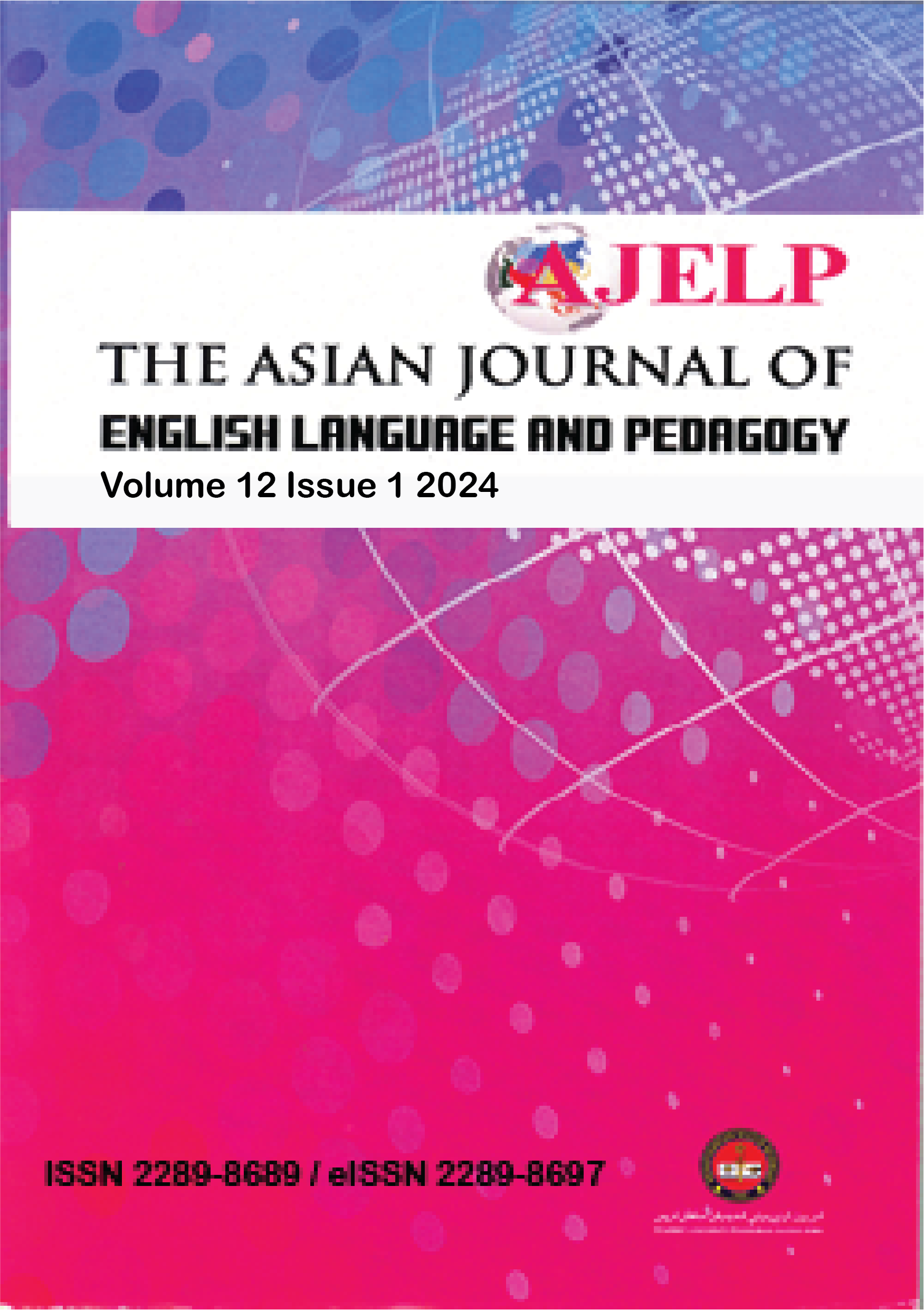Exploring Students’ Levels of Oral Presentation Apprehension in ESL Context
DOI:
https://doi.org/10.37134/ajelp.vol12.1.6.2024Keywords:
ESL context, oral presentation apprehension, second language learningAbstract
The study was aimed to investigate ESL students’ levels of oral presentation apprehension. All postgraduate students from Faculty of Education of a public university in Malaysia participated in this study. It is a qualitative study, and data needed for the study were extracted from McCroskey’s Personal Report of Public Speaking Anxiety (PRPSA). The participants answered 34 Likert-scale items, and the data were analysed by using PRPSA scores formula. Participants who scored more than 131 were considered to have a high level of oral presentation apprehension, and those who scored below than 98 were considered to have a low level of oral presentation apprehension. Besides, the moderate level of oral presentation apprehension was determined by the number of scores ranged from 98 to 131. Descriptive analysis was also performed by using SPSS. The findings reveal that overall, the participants have a low level of oral presentation apprehension. 66.7% of the participants had a low level of oral presentation apprehension, 29.2% had a moderate level of oral presentation apprehension, and only 4.2% had a high level of oral presentation apprehension. Furthermore, it was reported that the external and internal effects of oral presentation apprehension experienced were rated negatively by the participants. However, the scores for the internal effects were higher compared to the external effects. This is believed due to the participants’ high exposure to the oral presentation activity and pedagogical trainings as well as their language proficiency.
Downloads
References
Bećirović, S. (2020). Motivation, anxiety and students’ performance. Ahmetović, E., Bećirović, S., and Dubravac, 2020, 271-289.
Brooks, C., Burton, R., van der Kleij, F., Ablaza, C., Carroll, A., Hattie, J., & Neill, S. (2021). Teachers activating learners: The effects of a student-centred feedback approach on writing achievement. Teaching and Teacher Education, 105, 103387.
Cattell, R. B. and Scheier, I. H. (1963). Handbook for the IPAT anxiety scale (2nd ed.). Champaign, IL: Institute for Personality and Ability Testing.
Croucher, S. M., Kelly, S., Nguyen, T., Rocker, K., Yotes, T., & Cullinane, J. (2024). A longitudinal analysis of communication traits: communication apprehension, willingness to communicate, and self-perceived communication competence. Communication Quarterly, 72(1), 99-119.
Getie, A. S. (2020). Factors affecting the attitudes of students towards learning English as a foreign language. Cogent Education, 7(1), 1738184.
Horwitz, E. K., Horwitz, M. B., & Cope, J. (1986). Foreign language classroom anxiety. The Modern Language Journal.
Hussin, S. H., & Makmur, A. N. (2021). Speaking in English: oral communication apprehension and self-perceived communication competence among marketing undergraduates in Malaysia1. Development and Society, 22(3), 74-83.
Kashinathan, S., & Aziz, A. A. (2021). ESL Learners’ Challenges in Speaking English in Malaysian Classroom. International Journal of Academic Research in Progressive Education and Development, 10(2), 983–991.
Kho, M. G. W., & Ting, S. H. (2021). Oral Communication Apprehension in Oral Presentation among Polytechnic Students. Human Behavior, Development & Society, 22(2).
Kho, M. G. W., & Ting, S. H. (2023). English Proficiency, Public Speaking Experience, and Communication Apprehension in Oral Presentation of Polytechnic Students. Leksema: Jurnal Bahasa dan Sastra, 8(1), 55-66.
Jalleh, C. M., Mahfoodh, O. H. A., & Singh, M. K. M. (2021). Oral Communication Apprehension among Japanese EFL International Students in a Language Immersion Program in Malaysia. International Journal of Instruction, 14(2), 155-178.
Łodej, M., & Osmoła, A. (2024). Emotions in Language Learning: Understanding Foreign Language Enjoyment and Anxiety in Higher Education. Neofilolog, (62/1), 78-104.
McCroskey, J. C. (1970). Measures of communication‐bound anxiety.
McCroskey, J. C. (1977). Oral communication apprehension: A summary of recent theory and research. Human communication research, 4(1), 78-96.
McCroskey, J. C. (1984). The communication apprehension perspective. Avoiding communication: Shyness, reticence, and communication apprehension, 13-38.
MacIntyre, P. D. & Gardner, R. C. (1989). Anxiety and secondlanguage learning: Toward a theoretical clarification. Language Learning, 39, 251-275.
MacIntyre, P. D. & Gardner, R. C. (1991). Methods and results in the study of anxiety in language learning: A review of the literature. Language Learning, 41, 85-117.
Malaysia Ministry of Education. (2013). Malaysia Education Blueprint 2013-2025.
Piniel, K., & Zólyomi, A. (2022). Gender differences in foreign language classroom anxiety: Results of a meta-analysis. Studies in Second Language Learning and Teaching, 12(2), 173-203.
Ran, C., Wang, Y., & Zhu, W. (2022). Comparison of foreign language anxiety based on four language skills in Chinese college students. BMC psychiatry, 22(1), 558. https://doi.org/10.1186/s12888-022-04201-w
Rauf, F. H. A., Khalid, F. M., Shokri, N. A. M., & Sayid Abdullah, S. P. N. (2021). Demographic Factors and Oral Communication Apprehension among Students in Malaysian Higher Learning Institutions. Global Business & Management Research, 13.
Rimkeeratikul, S. (2023). Communication Apprehension and Intercultural Communication Apprehension among MA Students at a Public University in Bangkok. LEARN Journal: Language Education and Acquisition Research Network, 16(1), 429-447.
Sparks, R. L., & Alamer, A. (2024). Language anxiety does not affect the growth of L2 reading achievement: The latent growth curve model approach. Applied Psycholinguistics, 1-22.
Spielberger, C. (1966). Anxiety and behavior. New York, NY: Academic Press.
Spielberger, C. (1983). Manual for the state-trait anxiety inventory (Form Y). Palo Alto, CA: Consulting Psychologists Press.
Yang, Y. F., Hsieh, W. M., Wong, W. K., Hong, Y. C., & Lai, S. C. (2022). Reducing students’ foreign language anxiety to improve English vocabulary learning in an online simulation game. Computer Assisted Language Learning, 37(3), 410–432. https://doi.org/10.1080/09588221.2022.2039203
Downloads
Published
How to Cite
Issue
Section
License
Copyright (c) 2024 Qistina Ibrahim

This work is licensed under a Creative Commons Attribution-NonCommercial-ShareAlike 4.0 International License.





